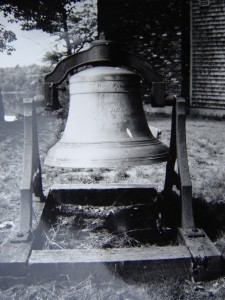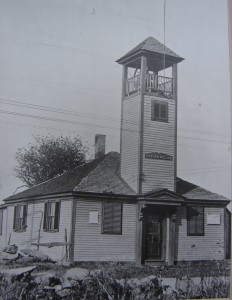“Bell City” by Julie Mofford
Julie Mofford, a former staffer at the Lowell Historic Preservation Commission, who currently lives in midcoast Maine where she writes and works as a museum and historical society consultant, shares this account of her past research on the bells of Lowell.
“Up before day at the clang of the bell and out of the mill by the clang of the bell – into the mills and at work in obedience to that ding-dong of a bell…” (Lowell Offering, “Spirit of Discontent,” 1845). Bells structured daily routine in the City of Lowell.
Reviving Lowell’s bell tradition was one mandate of the 1988 Lowell Cultural Plan. The Bell Committee, spearheaded by former Senator Paul Tsongas, was formed in the Spring of 1990 and included city officials and representatives of local business, cultural and academic communities. They originally hoped to install a 23-bell carillon atop the garage across from Boarding House Park then under construction. The Committee hoped to coordinate daily ringings of civic and church bells, something successfully coordinated by Lowell Historical Society, Lowell Museum and Human Services Corporation during America’s Bicentennial.
Peter Aucella, then Executive Director of Lowell Historic Preservation Commission, assigned me to research the city’s bell history and develop an exhibit at the Mogan Cultural Center. With the Bell Committee I was also to inventory bells and interview church officials as to the origins, makers, present condition and current use of their bells. They numbered over thirty though most churches now use tapes on timers that play hymns at specific times.
Transfiguration of Our Saviour on Clark Street and St. George’s on Bowers are among the Lowell churches using Schulmerich type electronic carillon systems. St. Anthony’s on Central Street has an electronic carillon with a loud speaker on the roof tolling four times daily. When Notre Dame de Lourdes on Smith Street was contacted the interviewer was told that though they have an electronic carillon system, “we don’t have a bell and we don’t have the Hunchback either!” The bell under the dome of Holy Trinity was cast by McShane Bell Foundry of Baltimore and is inscribed ‘Greek Orthodox Church, Holy Trinity, Lowell, MA. October 28, 1906.’ It tolls during regular services, on holy days and special occasions. Holy Trinity Polish Roman Catholic Church on High Street has a “peal of three bells with a total weight of 1240 pounds and was cast by Meneely Bell Company of Troy, NY in 1919” and is now electronic. Other churches told us that although they had belfries, they had no bells. St. Michael’s at Sixth and Bridge Streets said they had a 1479-pound bell cast by Meneely. Installed in 1923 it worked until 1973 when it “would ring but not swing.” Deemed unsafe, it was sold to a parishioner but realizing its historic significance, Father Bailey bought it back for $1000 where it sits on a platform between rectory and church.
Some bells required challenging detective work. Alan Manoian, currently Economic Development Specialist in Auburn, Maine, agreed to photograph the Coburn Mission Bell for the exhibit. After following a trail of interviews with Pawtucketville folks and combing through newspaper articles and deeds, he finally located the bell sitting in the side yard of a Westford residence. Built in 1755 as the Town of Dracut’s first schoolhouse, it stood on land that was annexed to Lowell in 1874. It became the Coburn Mission Church in 1900 and installed the bell cast by Meneely & Sons Bell Foundry of West Troy NY. This mysteriously vanished when the building was razed in 1966, sending Manoian on his wild bell chase.Stephen Briggs ascended the 1889 tower of the old fire station to photograph the alarm bell. In 1859 Lowell’s Fire Department purchased a steel bell for an earlier building so its sound could be distinguished from all other bells in the city. On June 22, 1860 the tower caught fire and though the bell appeared undamaged, it cracked during the next alarm. The present Romanesque Revival building was built in 1889 to replace another station that burned the previous year and this was a fire station until 1972. By 1890 the steel bell which hung in the tower of the police station had been removed to this engine house on Middle and Palmer Streets. A modernized bell code informed firemen what part of Lowell was ablaze. Various church bells were also linked to this alarm system.
One Lowell bell served as a protest against slavery. A Revere bell that hung in Chelmsford was sold to Pawtucketville Congregational Church in 1859. Delivered on December 2, it was the same day John Brown went to the gallows in Charlestown, (West) Virginia. The man who moved it by wagon had strong anti-slavery sympathies for he painted the bell with the abolitionist’s name to parade it across town.
One memorable morning I climbed St. Anne’s belfry with photographer Jim Higgins. The first church erected in Lowell boasts an eleven-bell carillon. On St. Anne’s 30th anniversary, the congregation decided the church needed its own bells “to grace the tower and toll the call to worship.” And they wanted “the fullest and most perfect bells which American skill and science could produce to add to the attractions of our beloved city.” Within eighteen months $4262.90 was raised by public subscription from 124 local citizens, “…Rich and poor, high and low, ladies and gentlemen, the children of the public schools…Every shade of religious opinion and political party have united to contribute this large sum of money while single bells have been given to perpetuate the memory of the departed, to honor the chief pastor of our church and the name of our respected rector…” The eleven bells totaled 9899 pounds weight and were cast by Jones & Hitchcock Company of Troy, New York, predecessors of C. H. Meneely Company. When installed this was considered the second chime of bells in America and the largest number to that date.
On October 17, 1857 the Reverend Theodore Edson noted the first ringing of St. Anne’s chimes in his diary: “…. Lizzie and I were at the arrival of the first train. People assembled numerously; church filled. At nine and three-fourths, the bells rung the changes. The wardens brought in the city government and seated the Mayor and aldermen…The bells were rung in the afternoon and evening and are believed to give satisfaction.” Mr. Harrison from Troy, NY, played the chimes in a “great variety of tunes; the novelty attracted crowds of our fellow citizens and there seems to be but one opinion…that these bells will prove one of the most attractive ornaments to the city.”
Not everyone was pleased however. Mr. Hinckley, superintendent of Merrimack Manufacturing Corporation who resided in the former parsonage, offered St Anne’s $2000 if the church would silence the bells. Rev. Edson thought it “most strange that Hinckley, along with other corporation men who had been making bell noises in this city for some 40 years, more of it and louder, should complain of the St. Anne’s chimes!”
James MacGowan, St. Anne’s bell-master, played St. Anne’s chimes for over fifty years and also rang the bells of St. Patrick’s. Jim proved indispensible to our Bell Committee, explaining how he played the bells and that each inscription had to be lettered at the time the bell was cast in a foundry.
The New England Folklife Center contributed information on ethnic bell traditions and borrowed artifacts from Southeast Asia to enrich the Mogan Cultural Center exhibit. The Boston & Maine Historical Society loaned a locomotive bell and another bell on exhibit was once used to summon field workers. A representative of Taylor’s in England, the world’s largest bell foundry, lent photographs and videos on the process of casting, tuning and hanging bells.
Public programs included a handbell concert and Evelyn and Edward Stickney who presented “Revere Reverberations.” The Bedford couple spent many years determined to locate every surviving Revere bell. This included one in Lowell’s First Baptist Church belfry cast by the Revere Foundry. A bill uncovered in the Revere Archives revealed that back in 1822, Kirk Boott bought a 900-pound bell from this foundry for $335.73. Hung in the Merrimack Manufacturing Corporation, this was likely the bell those early mill girls complained about.

